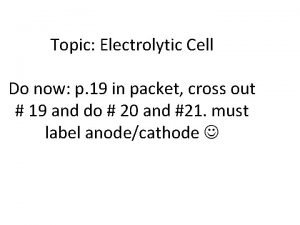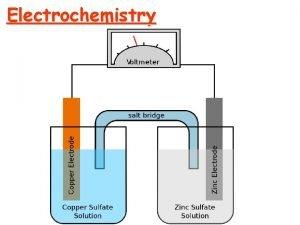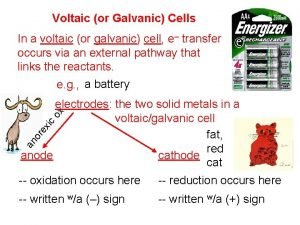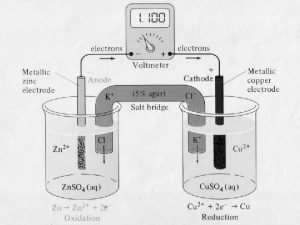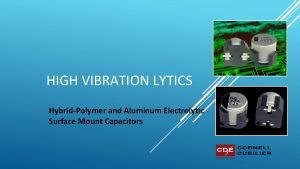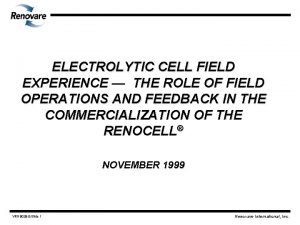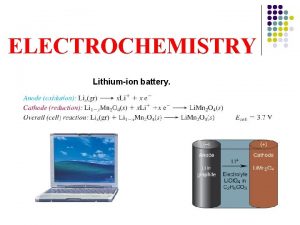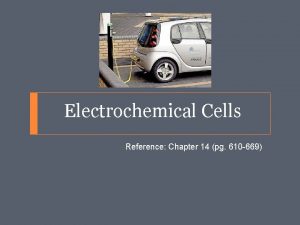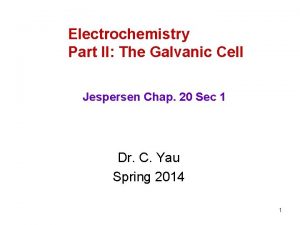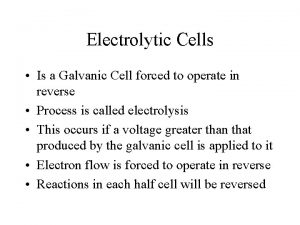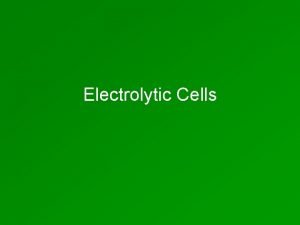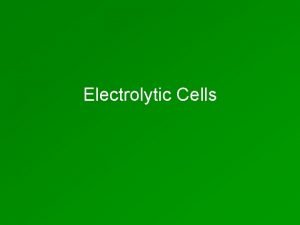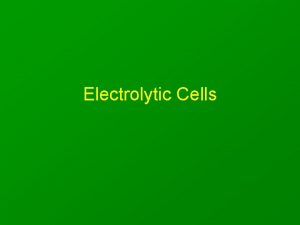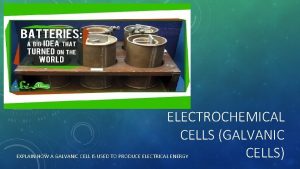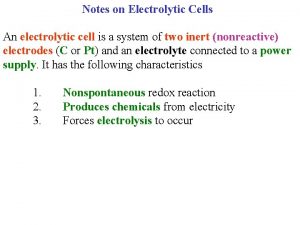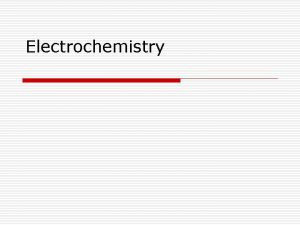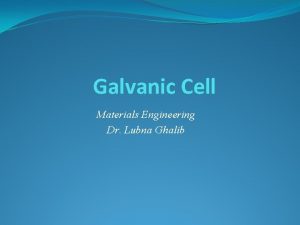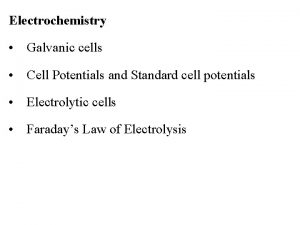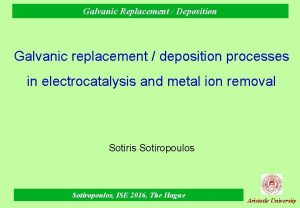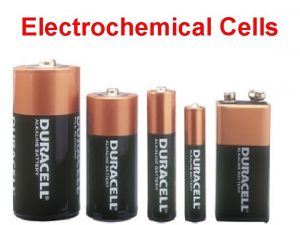Electrolytic Cells Is a Galvanic Cell forced to



















- Slides: 19

Electrolytic Cells • Is a Galvanic Cell forced to operate in reverse • Process is called electrolysis • This occurs if a voltage greater than that produced by the galvanic cell is applied to it • Electron flow is forced to operate in reverse • Reactions in each half cell will be reversed

Applications of Electrolysis • Electroplating – Plating of a thin layer of a metal on another metal to prevent corrosion or improve appearance • Extraction of Reactive Metals – Such as Sodium or Aluminium from their ores • Industrial Production – Sodium hydroxide, chlorine , hydrogen

Applications of Electrolysis • Recharging of Secondary Cells – Car batteries and Ni. Cads Increasing the thickness of the surface oxide layer of aluminium metal

Anode and Cathode • OXIDATION always occurs at the ANODE • REDUCTION always occurs at the CATHODE • In electrolytic cell, the polarity is decided by the way the external voltage is applied.

Anode and Cathode • Positive terminal makes the electrode it is attached to the ANODE, where oxidation occurs • Negative terminal makes the electrode it is attached to the CATHODE, where reduction occurs

Electroplating • A metal is coated with another to improve – Appearance – Durability – Resistance to Corrosion • Metal to be plated is connected to Negative electrode • Dipped in solution of ions of coating metal

Electroplating • Examples – Silver • Steel cutlery to make it more decorative and to prevent rusting – Chromium • Taps, tools and car parts to make them harder – Tin • Steel food containers to prevent contaminating food

Electroplating Cr 3+ (aq) + 3 e- Cr(s) – Cathode Cr(s) Cr 3+ (aq) + 3 e+ Anode Object to be Coated with Chromium Pure chromium electrode Solution of Chromium Ions

Electrowinning • Metals in Groups I and II as well as Aluminium are so easily oxidised their ores cannot be reduced by the usual chemical means. • The Halogens are strong oxidants and as such are difficult to obtain as pure gases

Electrowinning • In an electrolytic cell, reduction always occurs at the negative electrode and oxidation at the positive electrode • Hence these cells can be used to produce metals and the halogens from their ores.

Electrowinning • Because water is more easily readily reduced than these metal ions and more readily oxidised than the halogens these reactions cannot occur in aqueous solutions • Despite the expense, these elements can only be obtained by using their molten salts as electrolytes in electrolytic cells • Downs Cell is used to produce sodium and chloride

Downs Cell • Downs Cell is used to produce sodium and chloride Chlorine gas Sodium chloride added Cylindrical Iron cathode Sodium metal + Molten sodium chloride Mixed with calcium chloride + – Carbon ANODE

Downs Cell • Oxidation Reaction ANODE (–) – 2 Cl – (l) Cl 2 (g) + 2 e – • Reduction Reaction CATHODE (+) – Na+(l) + e– Na (l) • Overall Reaction – 2 Cl – (l) + Na+(l) Cl 2 (g) + Na(l)

Recharging Secondary Cells • The reactions which deliver the energy in secondary cells are reversed when the cells are recharged. • The overall reactions in each cell in a car battery are

Recharging Secondary Cells • When Discharging – Pb (s) + Pb. O 2(s) + 2 SO 4 2 – (aq) + 4 H+ – 2 Pb. SO 4 (s) + 2 H 2 O (l) • When Recharging – 2 Pb. SO 4 (s) + 2 H 2 O (l) – Pb (s) + Pb. O 2(s) + 2 SO 4 2 – (aq) + 4 H+

Car Battery Discharging Electron Flow Negative electrode Pb ANODE (oxidation) – Positive electrode Pb coated + With Pb. SO 4 CATHODE (reduction) Solution of sulphuric acid

Car Battery Recharging Electron Flow Negative electrode Pb coated – With Pb. SO 4 CATHODE (reduction) Positive electrode Pb coated + With Pb. SO 4 ANODE (oxidation) Solution of sulphuric acid

Car Battery • Discharging (Galvanic Cell) – ANODE (Oxidation) Pb (s) + 2 SO 4 2 – (aq) 2 Pb. SO 4 (s) + + 2 e – – CATHODE (Reduction) Pb. O 2(s) + 2 SO 4 2 + – + 4 H + 2 e 2 Pb. SO 4 (s) + 2 H 2 O (l) (aq)

Car Battery • Recharging (Electrolytic Cell) – CATHODE (Reduction) 2 Pb. SO 4 (s) + + 2 e – Pb (s) + 2 SO 4 2 – (aq) ANODE (Reduction) 2 2 Pb. SO + 2 H O Pb. O + 2 SO 4 (s) 2 (l) 2(s) 4 – + + 4 H + 2 e (aq)
 Voltaic vs electrolytic cells
Voltaic vs electrolytic cells Is anode positive or negative
Is anode positive or negative The cell reaction for the zn-h2 cell is
The cell reaction for the zn-h2 cell is Electrolysis khan academy
Electrolysis khan academy Applications of electrolytic cells
Applications of electrolytic cells Why are galvanic cells spontaneous
Why are galvanic cells spontaneous Electrochemistry
Electrochemistry Voltaic and galvanic cells
Voltaic and galvanic cells Half reduction reaction
Half reduction reaction Leclanche cell anode and cathode reactions
Leclanche cell anode and cathode reactions Cathode
Cathode Applications of electrolytic cell
Applications of electrolytic cell Smt for electrolytic cell
Smt for electrolytic cell Renocell
Renocell Electrolytic cell notation
Electrolytic cell notation Electrolytic cell
Electrolytic cell Applications of electrolytic cell
Applications of electrolytic cell Galvanic body spa results
Galvanic body spa results Nernst equation for galvanic cell
Nernst equation for galvanic cell Kno3 salt bridge
Kno3 salt bridge

